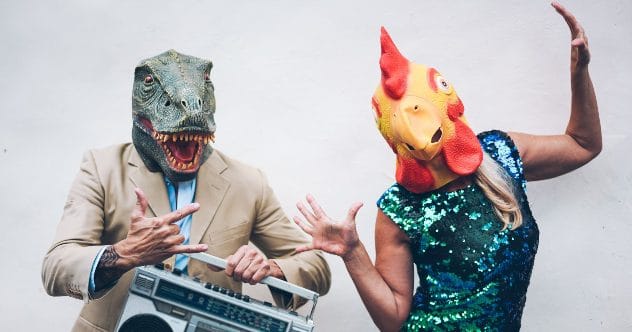Performance art is a realm where creativity knows no bounds, often venturing into the delightfully strange. This isn’t about shock for shock’s sake, but rather a deep dive into the unconventional expressions of artists. We’re embracing “the weird” as a testament to human imagination and the raw emotion that fuels groundbreaking art.
Often defined as a live artistic practice that goes beyond traditional media, performance art inherently seeks to express. These 10 live art performances highlight artists breaking free from censorship and conventional norms, offering unique and unforgettable experiences.
10. Butoh
Originating in post-WWII Japan during the late 1950s, Butoh is a contemporary Japanese performance art. Visionary choreographer Tatsumi Hijikata developed it as new art movements like French Surrealism and Dadaism began to influence Japan’s traditional performance scene. Butoh emerged as a rebel, rejecting established forms that emphasized strength and conformity. Instead, it found its voice in “weakness.” Some observers even noted its movements resembled the effects of mercury poisoning, a significant health issue in Japan at that time. The debut Butoh piece, “Forbidden Colours,” adapted from Mishima Yukio’s novel, featured Yoshito Ohno performing alongside Hijikata.
9. Parade (1917) by Erik Satie and Jean Cocteau
This groundbreaking ballet, first staged in 1917 by Ballet Russe, was a collaborative effort involving composer Erik Satie, poet Jean Cocteau, and surprisingly, Pablo Picasso, who designed the sets and costumes. Given the usually strict and traditional nature of ballet, Picasso’s avant-garde costumes, which included a two-person horse, were met with strong disapproval. The dancers found their movements heavily restricted by the bulky and oddly shaped designs, creating a performance far removed from audience expectations of the era. This was Satie’s first foray into ballet and his first collaboration with Picasso. The premiere was a disaster, with critics and audiences reacting negatively, even leading to a reported riot and an instance where Satie was allegedly slapped by an angry attendee.
8. Interior Scroll by Carolee Schneemann
Carolee Schneemann’s Interior Scroll was first performed in 1975 at the Women Here and Now exhibition in New York. The multidisciplinary artist, clad only in two sheets, mounted a table, disrobed, and painted her body. She then read from her book Cezanne, She Was a Great Painter, before astonishingly pulling a scroll containing feminist discourse from her vagina. This powerful and provocative performance was staged once more in 1977 at the Telluride Film Festival. Though initially invited to introduce a collection of erotic films by women, Schneemann chose to perform Interior Scroll again, motivated by her frustration with the collection’s titling.
7. Gavin Krastin’s BODY/BAG
Gavin Krastin is a South African choreographer, curator, and performance artist, and a vocal representative of the LGBTQ+ community. Known for his extreme and unconventional performance art, Krastin describes his work as an invitation for the audience to question societal definitions of ugly and beautiful. His piece, BODY/BAG, serves as a commentary on race and politics, though he leaves much of its specific meaning open to interpretation. This performance, along with EPOXY (2016), notably involved Krastin vacuum-sealing his nude body within a human-sized plastic bag. His other works are equally challenging, sometimes involving food being eaten off his naked body or attaching himself to a chair to dance.
6. Payau #2 Waterproof
Choreographed by Yola Yulifianti, an alumna of the Jakarta Institute of Arts (IKJ), Payau #2 Waterproof was a highlight of the 2012 Indonesia Dance Festival. This unique dance performance features movement synchronized to the rhythmic dripping of water. A particularly memorable segment involves a solo dancer performing with a pink bucket completely covering their head. Yulifianti’s choreography often delves into social issues within communities. Payau #2 Waterproof itself was developed through collaborative work with the residents of Penjaringan in North Jakarta, Indonesia, reflecting their local concerns.
5. Allan Kaprow’s Yard (1961)
In 1961, the iconic performance artist Allan Kaprow created an interactive art piece titled Yard. This work involved transforming a space in the Martha Jackson Gallery by filling it with car tires and other objects wrapped in tar paper. The audience was not merely passive observers; they were encouraged to climb on, interact with, and rearrange the tires freely. Kaprow is celebrated for pioneering the performance art concept known as “Happenings.” These are described as cross-disciplinary, non-text-based events that employ all available media, often blurring the lines between art and everyday life. In 2009, Yard was recreated by three artists to mark the opening of the New York Hauser & Wirth Gallery.
4. Bobby Baker’s Cook Dems (1990)
British performance artist Bobby Baker frequently uses food as a central medium in her art. While shows like Kitchen Show and Drawing on a Mother’s Experience are lauded for their sarcastic and witty takes on gender roles and domestic life, Cook Dems truly showcases her embrace of the bizarre. In this live performance, Baker decorates a man, clad only in a speedo, as if he were a cake. The man remains stoic, following Baker’s instructions as she paints him and smears him with icing. Later, in How to Live (2004), Baker took a frozen pea through an 11-step recovery program, reflecting her own experiences with mental health therapy. Her work often draws from deeply personal struggles, offering a unique blend of humor and vulnerability.
3. Lukas Avendaño
The art of Lukas Avendaño is a captivating experience that transcends simple description, weaving together dance, movement, sound, and props. Avendaño, an Oaxaca-born Muxe artist and anthropologist, explores profound themes of sexuality, gender, and Muxe identity. Much of their work incorporates partial nudity, using the body as the primary vessel for expression. Muxes are a community of indigenous people assigned male at birth who adopt traditional women’s roles, presenting not as women, but as muxes—a gender identity specific to Be’ena’ Za’a (Zapotec) culture. Avendaño’s performances are deeply rooted in this cultural identity, offering powerful and moving insights.
2. Wafaa Bilal’s …and Counting (2010)
Wafaa Bilal, a prominent Iraqi-American performance artist and art professor, often uses his work to explore themes of war, trauma, and surveillance. The tragic death of his brother Haji in a missile strike in Kufa, Iraq, profoundly influenced his artistic direction. In his 24-hour performance piece, “…and Counting,” Bilal had his back tattooed in front of visitors at the Elizabeth Foundation for the Arts in New York. The tattoo depicted a map of Iraq with dots representing Iraqi and American casualties—red for Iraqis and invisible UV ink (visible under blacklight) for Americans. This powerful piece also served as a fundraiser, generating $105,000 for scholarships for Iraqi and American students affected by the war. His other works, like 3rdi, where he surgically implanted a camera in the back of his head, provoke dialogue about surveillance in modern society.
1. Senga Nengudi’s R.S.V.P.
Senga Nengudi is an acclaimed African-American visual artist whose influential career began alongside other black avant-garde artists in New York and Los Angeles during the 1970s and 1980s. She played a pivotal role in spaces like Just Above Midtown (JAM) and the Pearl C. Woods Gallery, paving the way for future black women in visual and performance arts. R.S.V.P. is a series of performances and installations that utilize “previously worn, dark-hued pantyhose partially knotted into pendulous, sand-filled sacks, then stretched and tethered to the wall in various changing arrangements.” These installations then become dynamic stages for performance, where Nengudi and collaborators, such as Maren Hassinger, interact with and entangle themselves within the stretched pantyhose, exploring themes of elasticity, bodily experience, and resilience.
These performances, each weird and wonderful in its own way, showcase the limitless potential of art to challenge, provoke, and inspire. They remind us that sometimes, the most profound statements come from the most unexpected places.
What’s the weirdest live art performance you’ve ever encountered or heard about? Share your thoughts in the comments below!










